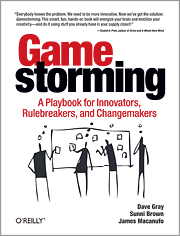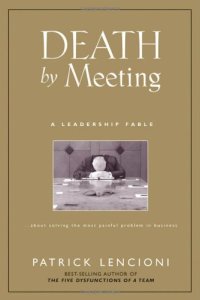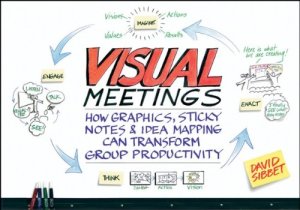Meetings can be oh-so-very boring. I have sat through my fair share of dull, uninspired, and ineffective meetings at work and church. And I have often wondered (while sitting through such meetings) why so many people go through the motions when it seems like a royal waste of time.
 After reading the book summary of Gamestorming, I immediately borrowed it from the library. In this book, the authors Dave Gray, Sunni Brown, and James Macanufo have compiled more than 80 “games” that can be used to make your meetings more engaging, effective, and fun.
After reading the book summary of Gamestorming, I immediately borrowed it from the library. In this book, the authors Dave Gray, Sunni Brown, and James Macanufo have compiled more than 80 “games” that can be used to make your meetings more engaging, effective, and fun.
Games are fun! I love playing games. They seem to be the complete opposite of a work meeting, and that’s why I love this concept. There’s an element of surprise and excitement when a game is introduced in a meeting – something out of the ordinary boring meeting. When participants are engaged, then you can make the most of their creativity and ingenuity, thus making the most of the meeting. These games apply to any formal setting where a discussion is happening (work meeting, small group at church, family dinner discussion, board meeting, etc.)
Here are a few games that I liked from the book:
1) Trading Cards
This game is a great way to get players to get to know each other better, and makes an excellent ice-breaker. Each player gets an index card, and they are to create a personal “trading card” that includes a self-portrait, a nickname for their “player”, and one thing unique about themself. Have players pass around the trading cards until they find one they would ask a question about. Once everyone has someone else’s trading card, go around the room and have each person ask their question.
2) The Anti-Problem
In this game, you ask players to identify ways to solve the problem opposite to their current problem. For example, if your goal is to increase customers at your retail store, then you would ask people to solve the anti-problem: How do you decrease customers at your retail store? This game’s purpose is to get people to evaluate a problem from a different perspective, and discover things that they are doing that are contributing to the actual problem.
3) Brainwriting
This game is a simple way to generate multiple ideas and build on them. Here’s how you play:
1. Start with a topic like “Improving Employee Morale”.
2. Distribute a large index card to each player and ask them to write down an idea.
3. Have players pass their index card to the right (or fold it into a paper airplane and fly it to another participant).
4. Read the idea on the index card just received and add an idea inspired by the original idea.
5. Continue the process until there are multiple ideas on each card.
4) Pre-Mortem
A common phase people use is “Hindsight is 20/20”. In this game, players identify why a project failed miserably (before the project begins). They are asked the question, “What will go wrong?” or “How will this end in disaster?” A pre-mortem is a great way to identify at the beginning of a project, what the greatest risks are.
5) Button
This game addresses the challenges of the “let’s go around the rooom and hear everyone’s idea” routine. The problem with going around the circle is that it is so predictable, and once a person answers they may zone out. One solution is to use a “button” (a small token like a poker chip) that is given randomly to a person to speak. After that person shares, he/she passes it to a person who has yet to receive the button. Randomization helps to keep the participants’ attention.
6) Design the Box
In this game, teams create a physical “box” that sells their idea. By imaging the packaging for the idea, whether it is a product or not, the teams make decisions about the important features of the idea and other aspects that are often hard to articulate. The box becomes a focusing device for the name of the idea, possible customers/end users, features, functions, and other important defining details. After creating the box, have each team “sell” their idea-in-a-box.

photo credit: Lars Plougmann via photopin cc
With a little preparation and creativity, meetings can be exciting and an effective use of everyone’s time. The onus is on the meeting facilitator/chairperson to find ways (and games) to engage everyone.
Gamestorming [affiliate link] is one of those books that doesn’t have to be read cover to cover. If you need ideas for an upcoming meeting, pick it up from the library or bookstore and flip through it to get inspired.
Here are a few more recommended reads to Improve Your Meetings:
– Death By Meeting – by best-selling author Patrick Lencioni – This book is a fictional story, which makes it easy to read, with real lessons and applications
– Visual Meetings: How Graphics, Sticky Notes and Idea Mapping Can Transform Group Productivity – by David Sibbet – This book has lots of great idea on how to use visual tools to energize your meetings


– Read This Before Our Next Meeting – by Al Pittampalli – This is a short book that explains what’s wrong with “the meeting,” and meeting culture, but suggests how to make meetings more effective, efficient, and worthy of attending. Here are a few great quotes from this book:
“I wonder when we’ll realize what a trap we’ve set for ourselves. Regularly interrupting the day to bring our best minds together to focus on the urgent makes it impossible for these people to spend their focused energy on what’s actually important.”
“The Modern Meeting focuses on the only two activities worth convening for: conflict and coordination”.
“In the Modern Meeting, we invite only the people who are absolutely necessary for resolving the decision that has been prepared.”
“Preparing an agenda involves thinking through what’s going to happen at the meeting – what the objectives are, who should be invited, what they should bring, and how long the meeting will last. Second, agendas establish the decision that is being discussed and elicits feedback and suggestions.”
“In the Modern Meeting, minutes are not required. We don’t need to know the details of what happened at the meeting, because it’s the same thing that happens at every Modern Meeting: conflict and coordination. All we need to know is the decision and the resulting action plan.”
